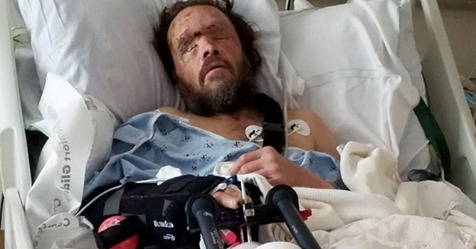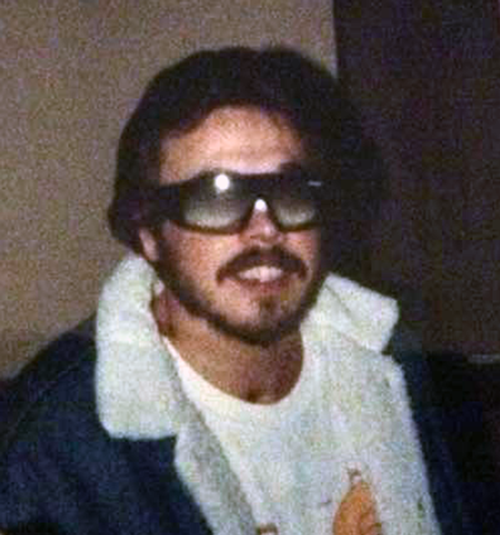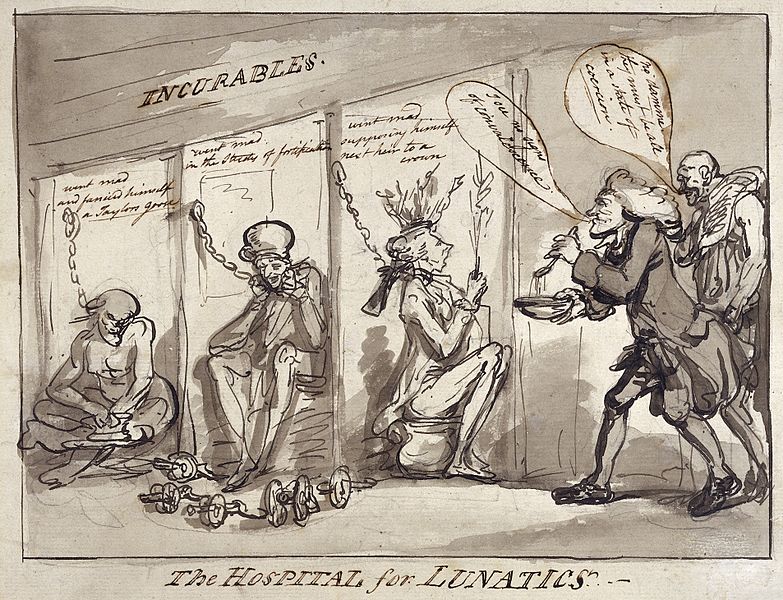In a town in America, here in the Twenty-first century, a man has been left to die. A maimed and blind and deeply mentally ill man.
He has been left to die in this town for thirteen years. Right out in public, on the city streets, where everybody can see him. And beat him and rob him when they feel like it. And nobody with any statutory power over his predicament seems to give a damn.
A technical clarification: this man is not on the streets of Vacaville as I write these words. He is in critical condition in a hospital, bandaged and splinted and broken after being struck by a car at a traffic intersection at dusk on February 12. (It is the second time this man has been hit.)
His injuries include a fractured skull and bleeding from the brain, facial lacerations, lung contusions, a dislocated shoulder, a shattered elbow, a decimated leg, and bruises that blanket his body.

But it’s a safe bet that after the surgeons have him all fixed up—it could take months—he will be ushered back out onto the streets, where the cars he can’t see and the thugs whom he cannot fend off will help him resume his accustomed existence.
The man has a name: (James) Mark Rippee. The city has a name: Vacaville, California. The situation has a name: depraved indifference to the survival of a human being.
I just made that name up. Actually, I borrowed it from legal parlance. Its definition: “Conduct which is so reckless, wanton and deficient and lacking in regard for the lives of others as to warrant the same culpability as the individual who actually commits a crime.”
Here is the crime that Mark Rippee has committed: the crime of existing while crippled, blind, and insane. Are there any questions?
I’m sure there are lots of questions. I have lots of questions myself. Or I used to. I have written so often about Mark Rippee since I became aware of his plight that the words I write about him seem to turn to dust. I have written blog posts about him here and here and here. I have written speeches to mental-health reform groups in which I summarize his story. I have written directly to media outlets, to lawmakers, and to civic leaders in Vacaville and elsewhere. And the streets still claim Mark Rippee.
The bare-bones story—as it were—is that Mark Rippee was involved in a terrible motorcycle crash in June 1987, at age 24, that left him nearly dead, with bits of his brain scattered near the site, his eyes and his right leg destroyed. You can read the details in my links.
Somehow he survived. But over the years, his traumatic brain injury (TBI) has morphed into schizophrenic-like thoughts and behavior. His power to reason vanished. His mother and his twin sisters Linda Privatte and Catherine J. Rippee-Hanson tended him in the family household for eighteen years, until his deformed brain turned him into a raging menace. He left the household and has made his way on the streets, where his sisters—both of whom have developed serious illnesses of their own—bring him food, clothing, canes. Vandals keep stealing all of it, and often also the money given him for food and other needs.
Why doesn’t somebody rescue Mark Rippee? Why doesn’t some agency . . . why doesn’t . . .
Those are very good questions, and I’m glad you asked them. But the answers are buried within the folds of incoherence that comprise so much of the American mental healthcare system. Or systems. Or “systems.”
Mark Rippee is a victim of a perfect storm of gothic bureaucracy. The pertinent bureaucrats at Solano County and California state levels have exhibited no discernible interest in finding any way to counter the bureaucratic snafus with a humane solution that would get this man into supervised care and treatment.
One might even say that they are hiding behind a “humane solution” that actually exists. This solution would begin with a declaration from a psychiatrist that Mark Rippee’s accident left his brain with “diminished capacity.” This ruling would permit Mark’s family to place him in an appropriate facility and/or to establish a conservatorship that would give them discretion over his affairs, including psychiatric care.
No dice: hospital psychiatrists have consistently, and weirdly, denied that Mark Rippee has “diminished capacity.”
And the reasoning behind this confounding denial? Well, it’s none of your business what the reasoning is. The hospital is protecting Mark Rippee’s rights, you see. Protecting them by way of the cartoonish Health Insurance Portability and Accountability Act. HIPAA was designed to ensure a patient’s “privacy.” “Privacy” that prohibits even family members from learning the medical procedures and condition of a patient. There’s an irony there, in case you missed it.
Catherine and Linda have fought tooth and claw, over parts of three decades, to tear through the self-serving laws and policies that keep Mark in a near-feral state. Two years ago, Catherine plunged into work on a petition in support of a California bill known as AB 1971. AB 1971 would have expanded the existing definition of “gravely disabled” to include medical treatment for a patient if the lack of treatment “may result in substantial physical harm or death.” It would have secured treatment for Mark Rippee. Catherine collected 82,000 signatures in favor of the petition.
In April 2018, the Disability Rights Education and Defense Fund, one of several lobbies that oppose conservatorship and deny other needs of the mentally ill, signaled that it disapproved of AB 1971. The California Hospital Association also weighed in on the negative side.
AB 1971’s sponsors pulled the bill.
The sisters’ determination would be the stuff of heroic legend, if we lived in a country that valued heroic legend. In the wake of Mark Rippee’s second brush with death by an oncoming car he couldn’t see, Catherine has released a new petition. It demands intervention from California Governor Gavin Newsom to rectify this travesty of public policy. It reads in part: “While we hold the County of Solano and many officials, departments and agencies responsible for not preventing this second tragedy that we told them would happen – We also demand that the State of California and in particular – Governor Gavin Newsom – whom we have previously attempted to contact – PAY ATTENTION TO THIS SITUATION and ACT accordingly!”
Here is a link to the petition.
Moreover, thanks to the sisters and the Internet, word of Mark’s ordeal is spreading at the grass-roots level. Activists around the country, alerted to the nightmare, have begun writing letters demanding justice for Mark.
Here are two. Their tone of indignation and urgency is echoed by many more.
From Donna Erickson of Massachusetts:
“Hello, I’m writing to voice my concern, in regard to a homeless individual named James Mark Rippee. As you probably know, he is severely disabled both mentally and physically. Being blind only further complicates his poor condition. The real tragedy here is that none of this is his fault. Severe mental illness is a disease nobody chooses. Many who are afflicted are unaware of how sick they are, because of anosognosia, which is lack of insight, a condition that is a manifestation of the illness itself. It is not his fault that he repeatedly walks into traffic.
“His brain is broken, and he cannot see. Someone in this condition should never have been put on the street. So now he is hospitalized for another accident, resulting in critical injuries, including a skull fracture, brain bleed, and broken bones. He will need many surgeries.
“His family is devastated, because they tried so hard to get him off the streets. But the laws get in the way. This poor man requires a hospital, rehab, and eventually a long-term residential facility. If he is an elopement risk, then there are locked facilities. Mark’s value as a person is no less than any of us on Earth. He has fallen through the cracks of a very broken system.
“How would you feel if this was your family member? Mental illness can strike anyone. He is not a nobody. He is a family member of caring individuals who have tried everything in their power to help. The tragic part is that this all could have been avoided, if only someone had truly cared and listened. Keeping someone on the streets in his condition is disgraceful. And it shouldn’t matter what he says. He is unable to make a rational decision, which is in his best interest, due to his illness.
“The system has failed him, because no one intervened, even though the family had begged and pleaded. I had to voice my concern, because this could have been my son. This could have been anyone’s son, and we need to start taking care of our most vulnerable citizens!”
And from the Maryland advocate Laura Pogliano:
“My friend [Catherine] Hanson and her sister Linda Rippee have been trying to help their brother Mark for 13 years; a motorcycle crash left him with no eyes, a severe brain injury, broken bones all over his body, a metal rod in his leg, and as a result of TBI, schizophrenia. He’s been on the streets for years, being victimized, robbed, beaten and neglected. They’ve been denied help for him over and over by the county they’re in, by hospitals.
“He’s been admitted to, by group homes, by every support service you can think of. He was hit by a car a few months ago and while inpatient, one sister’s medical power of attorney was revoked, and the psychiatrist sided with his delusional raging patient, that he was capable of making his own medical choices and caring for himself (blind and floridly psychotic). He was discharged to a group home and lasted about a week.
“Now, living on the streets, Mark’s been hit by a car again! Only this time, he was thrown into the air and smashed his face against the driver’s windshield. He’s in bad shape, has another brain injury, the leg with the metal rods is shattered, his shoulder is dislocated and he might lose what’s left of his teeth.
“He’s going to need months of hospitals, multiple surgeries, and extended care. And guess what? He’s in the same damned hospital that battled back against his family and discharged him to the streets.
“Mental health care in America. You stand a slight, very slight chance of making it, if you’re healthy enough to ask for help and participate in it. If you’re really, really sick, you’re screwed.”
In a city in America, here in the Twenty-first century, a man has been left to die. But in America, the voices of reclamation are arising to insist on his right to live.



















